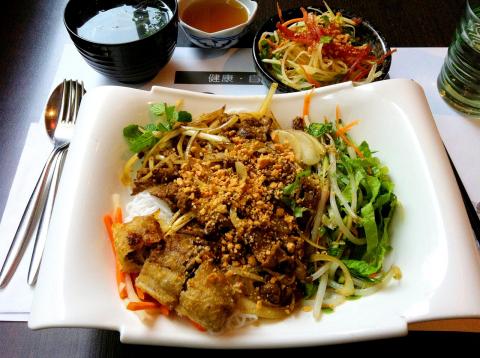The shop front sign at Viet Hong Lang (越香蘭), located near the corner of Fuxing North and Minsheng East roads in Taipei, reads “Vietnamese fusion cuisine,” which is somewhat misleading. The restaurant’s selection caters more to diners looking for a fancy twist to familiar dishes rather than those seeking a culinary adventure.
Still, the food is good and reasonably priced for what you get, and the chic Southeast Asian interior (walls painted in pastel green and maroon hues, silk lampshades) matches the neighborhood’s business district vibe without feeling too stuffy.
What caught my eye and lured me into Viet Hong Lang for lunch was its shop front window, which was filled with stacks of baguettes. Although the loaves in the window were leftovers only for display, the bread served by the restaurant is baked fresh daily and tastes delicious.

Photo: David Chen, Taipei Times
Try it as part of the banh mi (越南三明治, NT$70 for takeout, NT$120 when dining in), or Vietnamese sandwich. The baguette loaf, which measures around 20cm long, comes toasted so it’s crispy on the outside and soft on the inside. It’s filled with the standard ingredients: pickled carrot and julienne daikon, thin strips of cucumber, cilantro, cha lua (a light Vietnamese sausage), a few strips of smoked ham and a very light spread of sweet butter. The sandwich is a nice light lunch for those on the go.
A vegetarian version is available for NT$50, or have a plain baguette with either jam and butter (NT$50), condensed milk (NT$30), or “special house butter” (NT$60). These items are only available for takeout, but dining in, you can get the baguette with curry chicken (咖哩雞肉法國麵包, NT$160) or tomato sauce beef (茄汁牛腩法國麵包, NT$180).
Another recommendation is the deep-fried spring rolls with beef and vermicelli (越式春卷牛肉拌米粉, NT$160). I ordered this rice noodle salad dish with a hankering for spring rolls but came away most impressed with the accompanying strips of beef, which were grilled with onions and tasted like they were marinated in a curry sauce. The beef went well with the accompanying mix of fresh bean sprouts, sprigs of basil and mint, and a sprinkling of crushed peanuts. Compared with similar offerings at some of the better-known Vietnamese shops in Taipei — the Madame Jill’s chain, Thanh Ky (誠記越南麵食館) on Yongkang Street (永康街), Yue Yuan (越苑) on Dunhua North Road (敦化北路) — Viet Hong Lang’s versions topped them all.
The pho, on the other hand, is a tougher call. What Viet Hong Lang calls “rice noodle soup with rare and well-done beef” (生熟牛肉河粉, NT$160), was tasty and well prepared: the broth was fragrant; the dish comes with generous portions of fresh cilantro, bean sprouts, basil, mint and lemon; and the beef was of good quality. But together those elements didn’t leave a strong impression. It wasn’t bad, but unlike the sandwich or the vermicelli with beef, it wasn’t quite worth the trip.
Most noodle dishes are between NT$160 to NT$180, and a lunch set menu is offered for an additional NT$60, which consists of a choice of two of the following side dishes: papaya or chicken salad, borscht or soup with beef meatballs, a “dessert of the day” and coffee or tea. I had the papaya salad, which was zesty and refreshing, and a sago dessert with red beans, which could easily be skipped — it was bland and watery.
The menu selection is large and includes shared dishes such as shrimp rolls, salads and grilled meats, which range from NT$180 to NT$280.

That US assistance was a model for Taiwan’s spectacular development success was early recognized by policymakers and analysts. In a report to the US Congress for the fiscal year 1962, former President John F. Kennedy noted Taiwan’s “rapid economic growth,” was “producing a substantial net gain in living.” Kennedy had a stake in Taiwan’s achievements and the US’ official development assistance (ODA) in general: In September 1961, his entreaty to make the 1960s a “decade of development,” and an accompanying proposal for dedicated legislation to this end, had been formalized by congressional passage of the Foreign Assistance Act. Two

Despite the intense sunshine, we were hardly breaking a sweat as we cruised along the flat, dedicated bike lane, well protected from the heat by a canopy of trees. The electric assist on the bikes likely made a difference, too. Far removed from the bustle and noise of the Taichung traffic, we admired the serene rural scenery, making our way over rivers, alongside rice paddies and through pear orchards. Our route for the day covered two bike paths that connect in Fengyuan District (豐原) and are best done together. The Hou-Feng Bike Path (后豐鐵馬道) runs southward from Houli District (后里) while the

March 31 to April 6 On May 13, 1950, National Taiwan University Hospital otolaryngologist Su You-peng (蘇友鵬) was summoned to the director’s office. He thought someone had complained about him practicing the violin at night, but when he entered the room, he knew something was terribly wrong. He saw several burly men who appeared to be government secret agents, and three other resident doctors: internist Hsu Chiang (許強), dermatologist Hu Pao-chen (胡寶珍) and ophthalmologist Hu Hsin-lin (胡鑫麟). They were handcuffed, herded onto two jeeps and taken to the Secrecy Bureau (保密局) for questioning. Su was still in his doctor’s robes at

Mirror mirror on the wall, what’s the fairest Disney live-action remake of them all? Wait, mirror. Hold on a second. Maybe choosing from the likes of Alice in Wonderland (2010), Mulan (2020) and The Lion King (2019) isn’t such a good idea. Mirror, on second thought, what’s on Netflix? Even the most devoted fans would have to acknowledge that these have not been the most illustrious illustrations of Disney magic. At their best (Pete’s Dragon? Cinderella?) they breathe life into old classics that could use a little updating. At their worst, well, blue Will Smith. Given the rapacious rate of remakes in modern